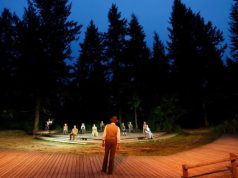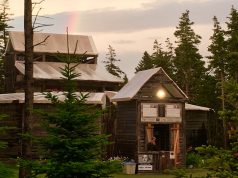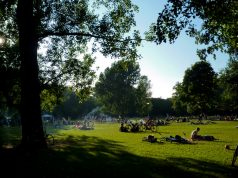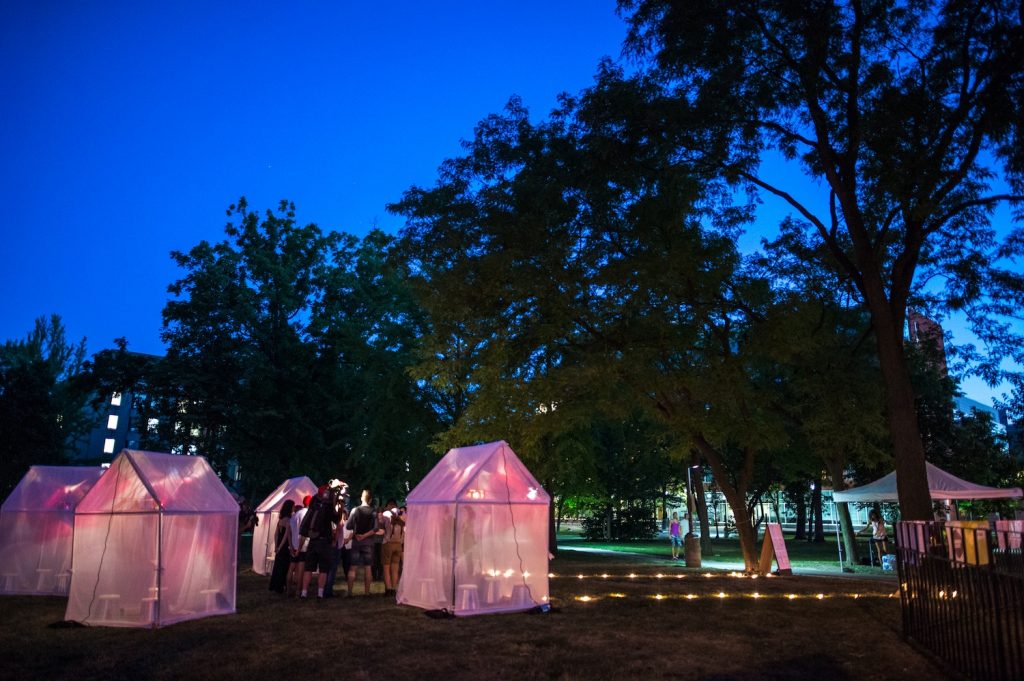
Trophy is an ever-evolving piece. What first started out as an awards ceremony performance has evolved into a performance and visual art installation consisting of 5 tents, which will shortly be evolving into an installation of 150 tents. Everything from our storytellers to our installation materials to the context provided by our location changes each time, creating a piece that is continually in flux. I used to think this was problematic until I realized that it makes sense that a piece about change and the turning points in life should itself transform each time, too. The question, as with all transitions, has become how to navigate this continuous change while still maintaining the integrity of the piece.
In its present incarnation, Trophy is five glowing tents, and inside each is a person telling a true story about a moment in their life when everything changed. Over the course of the performance, audience members go from tent to tent. After listening to a story, they’re encouraged to reflect on the turning points in their own lives and write down their own stories on colourful transparencies. These transparencies are then attached to the tents, transforming the tents over the course of the performances into multi-coloured translucent structures. In this way, the experience of Trophy becomes an expression of all participants’ stories, and an exploration and conversation about how we all experience change and how we are shaped by these experiences.
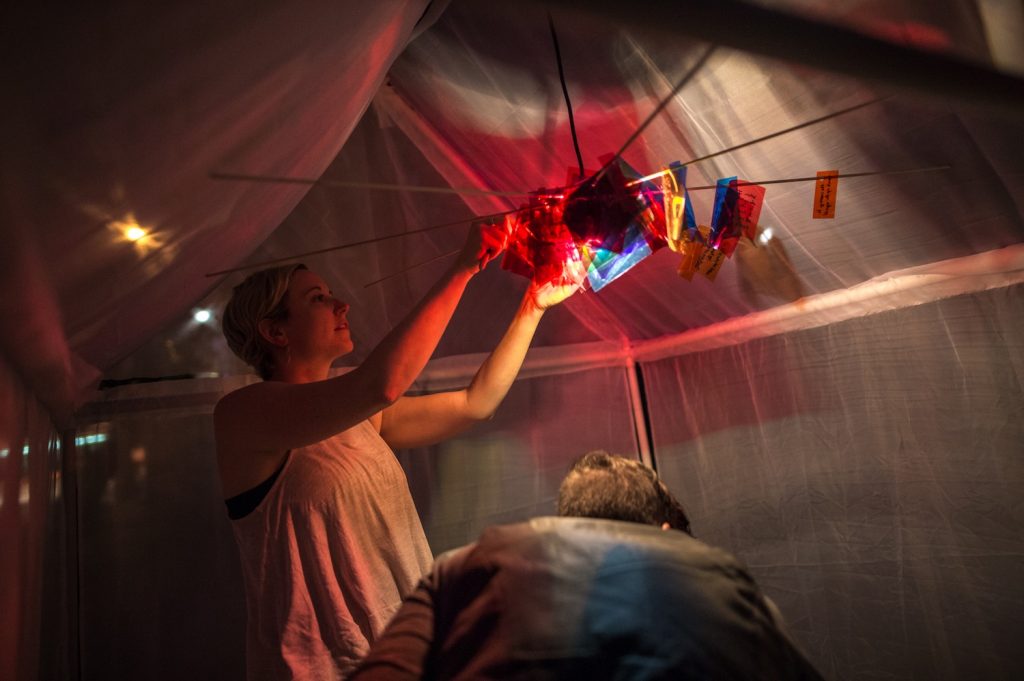
We choose storytellers who live in the city where we are presenting the show. The storytellers are not necessarily trained performers – the primary criteria are that they have an interesting story, that they are willing to work with us to flesh that story out, and that we get along. We aren’t trying to literally tell the story of the area, but we do want to make sure that the people who make up the community are represented.
Trophy is very much informed by the site – our first two performances of Trophy were at Nuit Blanche Ottawa+Gatineau and In the Soil Arts Festival (St. Catherines ON). In both cases, we were in the middle of a busy downtown street, where people had to walk through our installation as part of their daily lives. We deliberately spaced out our tents, allowing space for people to move through the installation and create their own paths. Most of our participants were not traditional theatre or art goers, and had no idea of the rules we normally place on art attending, and so they happily broke every single one.
We didn’t charge admission, and there was no real or metaphorical fence around our installation, so the interaction with Trophy became deeply casual and community-oriented. After trying to maintain a certain performance structure, we realized that people really just wanted to manage their own experiences, and so we opened it wide up, allowing people to visit as many tents as they felt like, join in when they wanted to and drop out whenever they were done. We relaxed our time constraints, and let people linger in the tents with our performers, deciding that what was more important than having an official “performance experience” was the intimate moments and community-building that was happening inside the tents, as people connected with their neighbours, told stories that they had never shared before, and experienced those moments of connection which are what Trophy is really about.
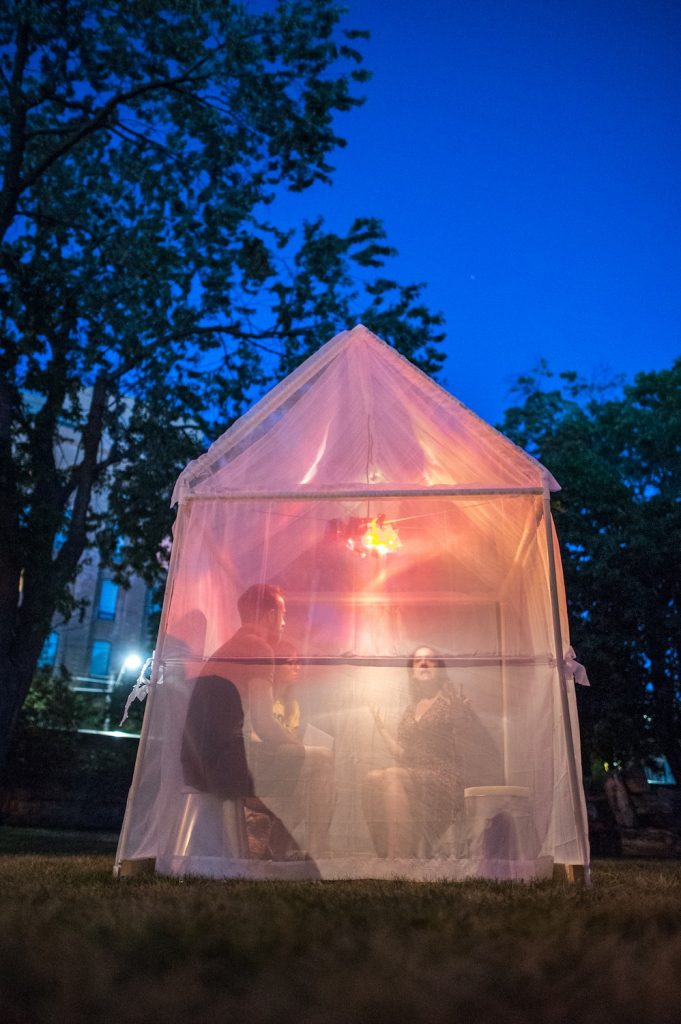
And then we moved to SummerWorks – a totally different context altogether. We were in the CAMH park on Queen West on a hot summer day, and there was a cost for tickets. We decided to add back in the formal structure that had been evolved out. Being on Queen West, especially in the evening, we started to get a lot of attention as our tents began to glow. A number of people mentioned that they would not normally want to be in that park after dark, and so it was interesting to have created a space where everyone was welcome – both the people who normally reside in the park, and the people who would normally avoid it.
Being in a park instead of the middle of the street forced people to choose to come into the installation. It was not so much another part of the fabric of the city, and more of a special thing that had popped up in an unusual place. There was a completely different sense of ownership by the participants – this time, the format of the piece stayed the same throughout the day, as participants respected our structure, following the more traditional rules of performance going. And so in this case, while previously it was the audience that evolved the piece, this time it was us who actually started to change, as we repeated Trophy over and over. Trophy is to be performed multiple times in one day – at SummerWorks, we did the piece six times, with performers telling their stories up to 30 times each. Through this experience, our performers’ stories deepened and expanded, and as the facilitators of the performance, we found small ways to increasingly care for our performers and participants as we led them through the experience. It was more about guiding, ritual, and care versus being taken over and reshaped by the audience. The show expanded and deepened in a completely different way.
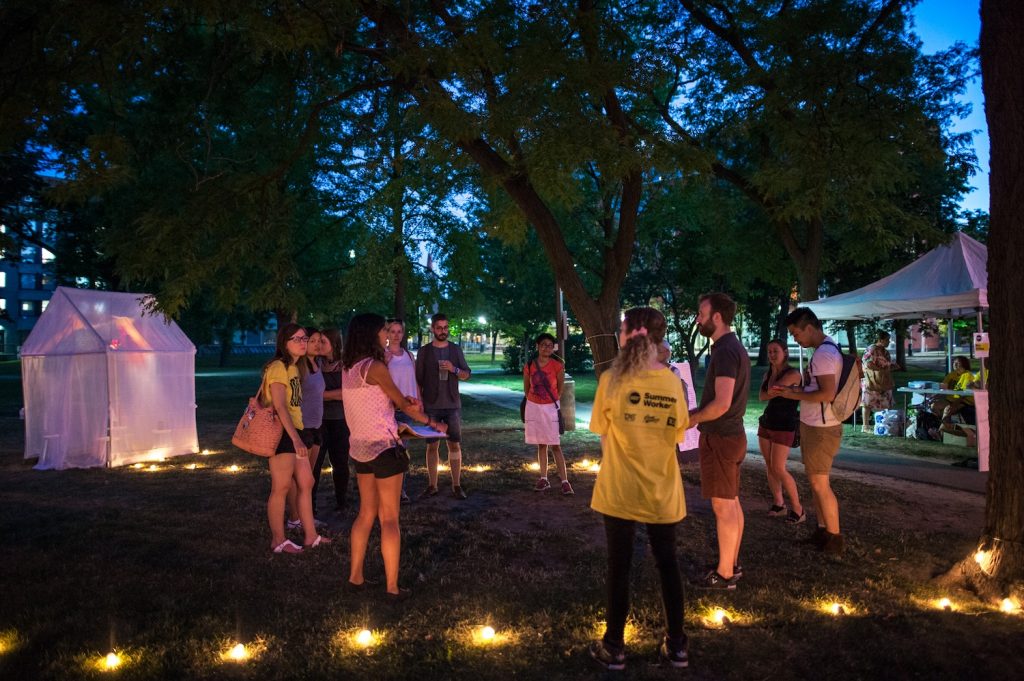
Allison O’Connor, Trophy’s co-creator and installation designer, and I often have conversations about what the point of Trophy is – are we creating something open and community-focused or is it about a polished finished piece? Can we create a piece that is porous enough for the audience to take it over and fully shape it, while still maintaining our artistic vision? How much control can you, or should you, exert in a piece that is about change? I like to think of Trophy as a ritual. In that context, the key moment of the ceremony is when the ritual itself takes over and we lose control. How do you create the possibility of that moment, while still having a space where the audience and performers can be guided and cared for?
As we start to prepare for our next version of Trophy, we are heading in the direction of even less control – we’re going to have 150 tents in a downtown street in Ottawa, where trying to control the audience experience will be even harder. In a world where so much is controlled, planned and processed, it feels both exhilarating and terrifying to create something that can literally be taken over. It feels exactly like those life turning points that we talk about in Trophy – it’s only in the relinquishing of control that the possibility of true change and transformation can occur. And so that’s what we’ll be doing – we’ll plan, lay groundwork, write proposals, make spreadsheets, have tons of meetings, rehearsals and conference calls, and then, when the audience arrives, we’ll let go, and see where the ritual takes us.






